What is rule of nine. Rule of Nines: A Crucial Tool for Burn Assessment and Treatment
What is the Rule of Nines. How does it help in estimating burn severity. Why is accurate burn assessment critical for proper treatment. What are the limitations of the Rule of Nines.
Understanding the Rule of Nines: A Vital Burn Assessment Method
The Rule of Nines is a crucial tool used in emergency medicine and burn care to quickly estimate the percentage of total body surface area (TBSA) affected by burns. This method divides the body into sections, each representing 9% or a multiple of 9% of the total body surface area.
Key Body Sections in the Rule of Nines
- Head: 9%
- Each arm: 9%
- Each leg: 18%
- Front torso: 18%
- Back torso: 18%
- Genitalia: 1%
These percentages can be further divided for more precise estimations. For instance, the front of one arm or half of the head would represent 4.5% of the TBSA.
Importance of Accurate Burn Assessment
Is accurate burn assessment critical for proper treatment? Absolutely. The Rule of Nines provides medical professionals with a quick and standardized method to estimate burn severity, which is crucial for determining appropriate treatment strategies. This information helps guide decisions about fluid resuscitation, skin grafting, and other interventions necessary for burn management.

Types of Burns: Understanding the Spectrum of Severity
Burns are classified into different degrees based on the depth of tissue damage. Recognizing the severity of a burn is essential for proper treatment and care.
First-Degree Burns
What characterizes a first-degree burn? These burns affect only the outermost layer of skin (epidermis), causing redness, pain, and dryness. They typically heal without scarring and don’t usually require the Rule of Nines for assessment.
Second-Degree Burns
Second-degree burns, also known as partial-thickness burns, penetrate deeper into the skin, affecting the dermis. They often result in blistering, swelling, and can leave permanent scars.
Third-Degree Burns and Beyond
Third-degree burns, or full-thickness burns, damage all layers of the skin and can affect underlying tissues. Fourth-degree burns extend to fat, fifth-degree to muscle, and sixth-degree to bone. These severe burns require immediate and intensive medical intervention.
Common Causes of Burn Injuries
Understanding the various causes of burns is crucial for prevention and proper initial care. Burns can result from several sources, each with its unique characteristics and treatment considerations.
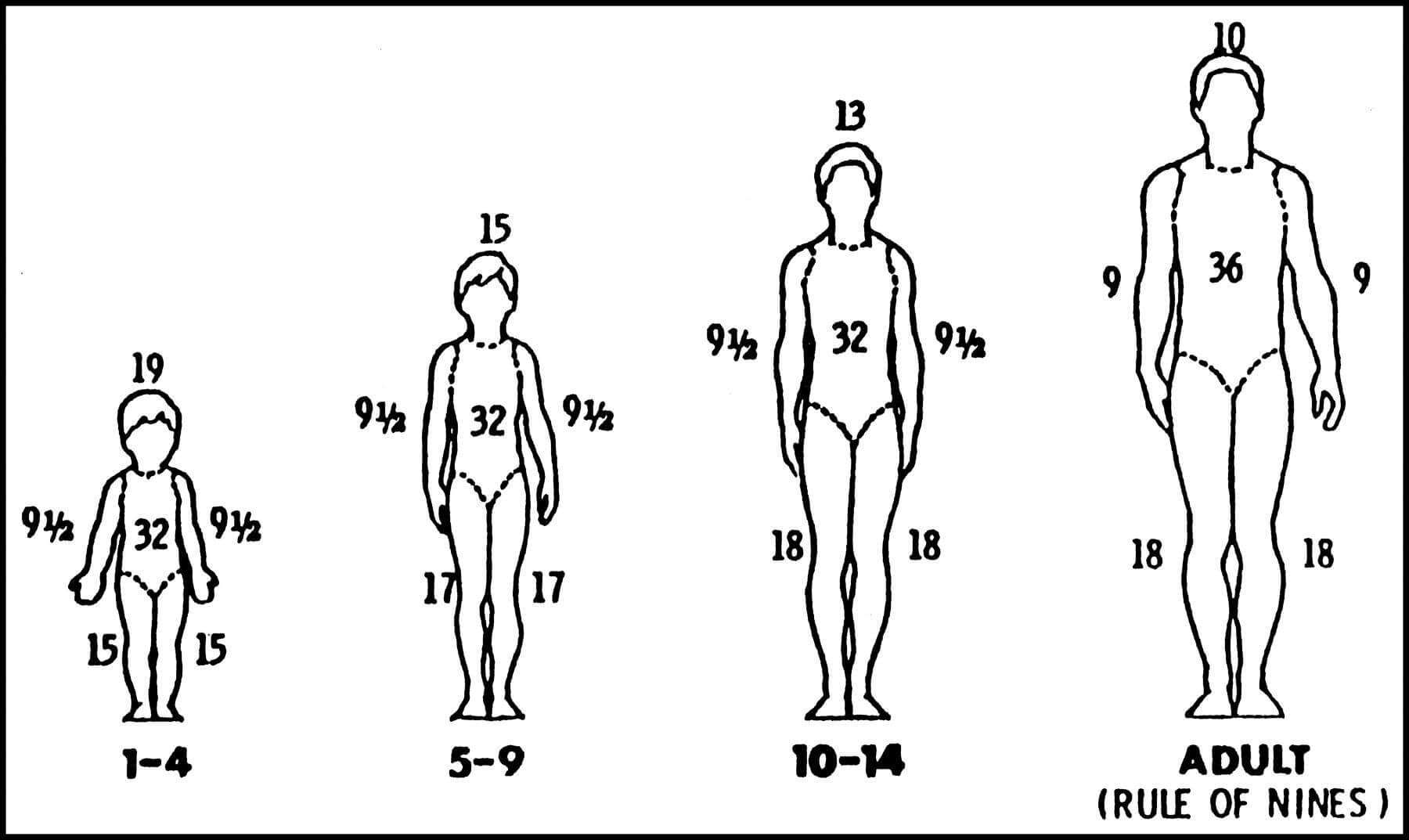
Thermal Burns
Thermal burns are the most common type of burn injury. They occur when skin comes into contact with heat sources such as:
- Open flames
- Hot liquids (scalds)
- Steam
- Heated objects
Electrical Burns
Electrical burns result from contact with electrical currents. These burns can be particularly dangerous as they may cause internal damage not immediately visible on the skin’s surface. Common sources include:
- Exposed wires
- Faulty electrical equipment
- Lightning strikes
Chemical Burns
Chemical burns occur when skin comes into contact with corrosive substances. These can include household products and industrial chemicals such as:
- Strong acids or bases
- Bleach
- Battery acid
- Industrial solvents
The Role of the Rule of Nines in Emergency Response
How does the Rule of Nines aid emergency medical responders? This tool allows for rapid assessment of burn severity in the field, enabling first responders to make critical decisions about immediate care and treatment priorities.
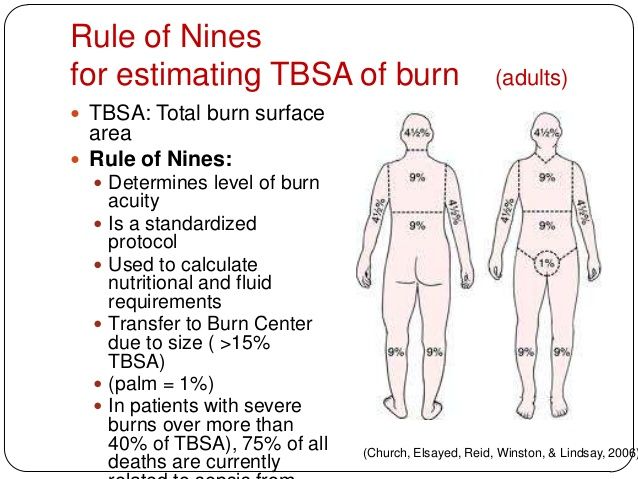
Quick Assessment in Critical Situations
In emergency scenarios, time is of the essence. The Rule of Nines provides a standardized method for quickly estimating the extent of burns, allowing responders to:
- Determine the severity of the burn injury
- Assess the need for immediate fluid resuscitation
- Make informed decisions about transport and treatment facilities
- Communicate effectively with receiving medical teams
Burn Treatment Strategies Guided by the Rule of Nines
The estimation of burn surface area using the Rule of Nines directly influences treatment decisions. This information is crucial for determining the appropriate course of action and preventing complications.
Fluid Resuscitation
Why is fluid resuscitation critical in severe burn cases? Extensive burns can lead to significant fluid loss and electrolyte imbalances. The Rule of Nines helps calculate the amount of intravenous fluids needed to prevent shock and maintain organ function.
Skin Grafting Procedures
For larger burns, skin grafting may be necessary to promote healing and prevent infection. The Rule of Nines assists in planning these procedures by providing an estimate of the affected area, helping surgeons determine the extent of grafting required.

Limitations and Considerations of the Rule of Nines
While the Rule of Nines is a valuable tool, it’s important to recognize its limitations and potential for inaccuracy in certain situations.
Body Type Variations
Does the Rule of Nines apply equally to all body types? Not exactly. The standard percentages may not be accurate for:
- Children under 14 years old
- Individuals with obesity
- People with unique body proportions
In these cases, modified versions of the rule or alternative assessment methods may be necessary.
Human Error in Estimation
The accuracy of the Rule of Nines can be affected by human error, especially in cases where burns are irregularly shaped or distributed across multiple body regions. This potential for inaccuracy underscores the importance of combining the Rule of Nines with other assessment methods and clinical judgment.
Advancements in Burn Assessment Technology
While the Rule of Nines remains a valuable tool, technological advancements are enhancing burn assessment accuracy and efficiency.
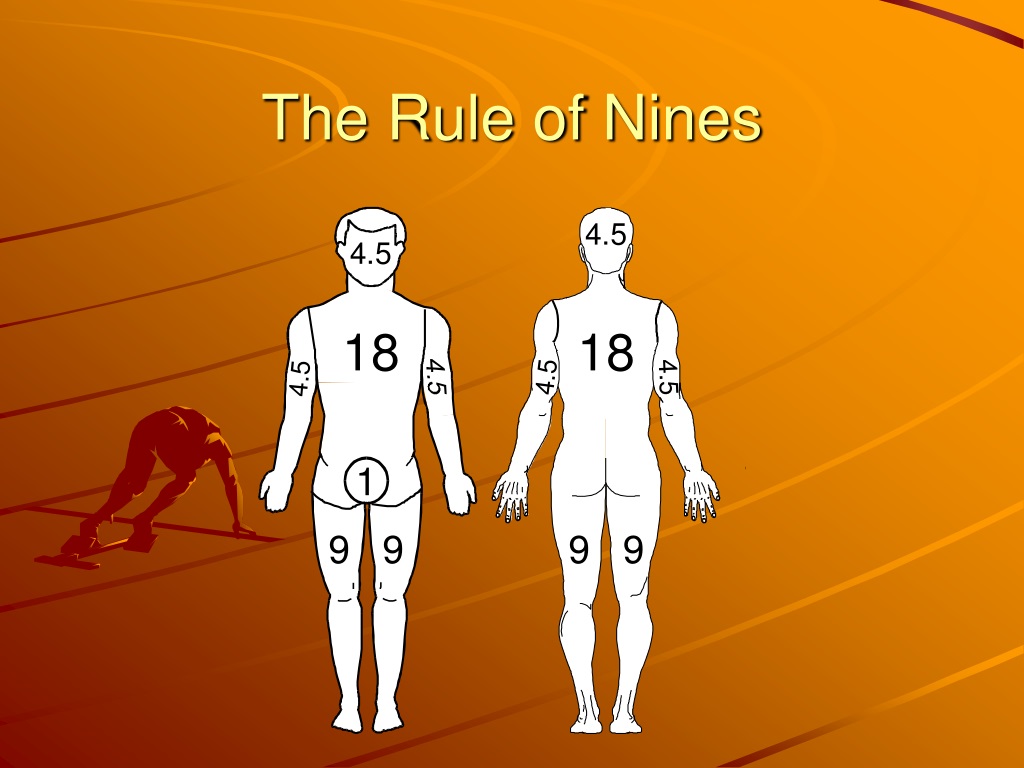
Digital Imaging and AI-Assisted Assessment
How are digital technologies improving burn assessment? New software applications use digital imaging and artificial intelligence to analyze burn photographs, providing more precise TBSA calculations. These tools can complement the Rule of Nines, especially in complex cases.
3D Body Scanning
Three-dimensional body scanning technology is emerging as a promising method for accurate burn surface area calculation. These systems can account for individual body variations and provide highly detailed measurements.
The Importance of Comprehensive Burn Care
While accurate assessment using tools like the Rule of Nines is crucial, effective burn treatment requires a holistic approach to care.
Pain Management and Psychological Support
Burn injuries often involve significant pain and psychological trauma. Comprehensive care includes:
- Appropriate pain management strategies
- Psychological counseling and support
- Rehabilitation services to address functional impairments
Long-Term Follow-Up and Scar Management
What happens after the initial burn treatment? Long-term care is essential for optimal recovery. This may include:
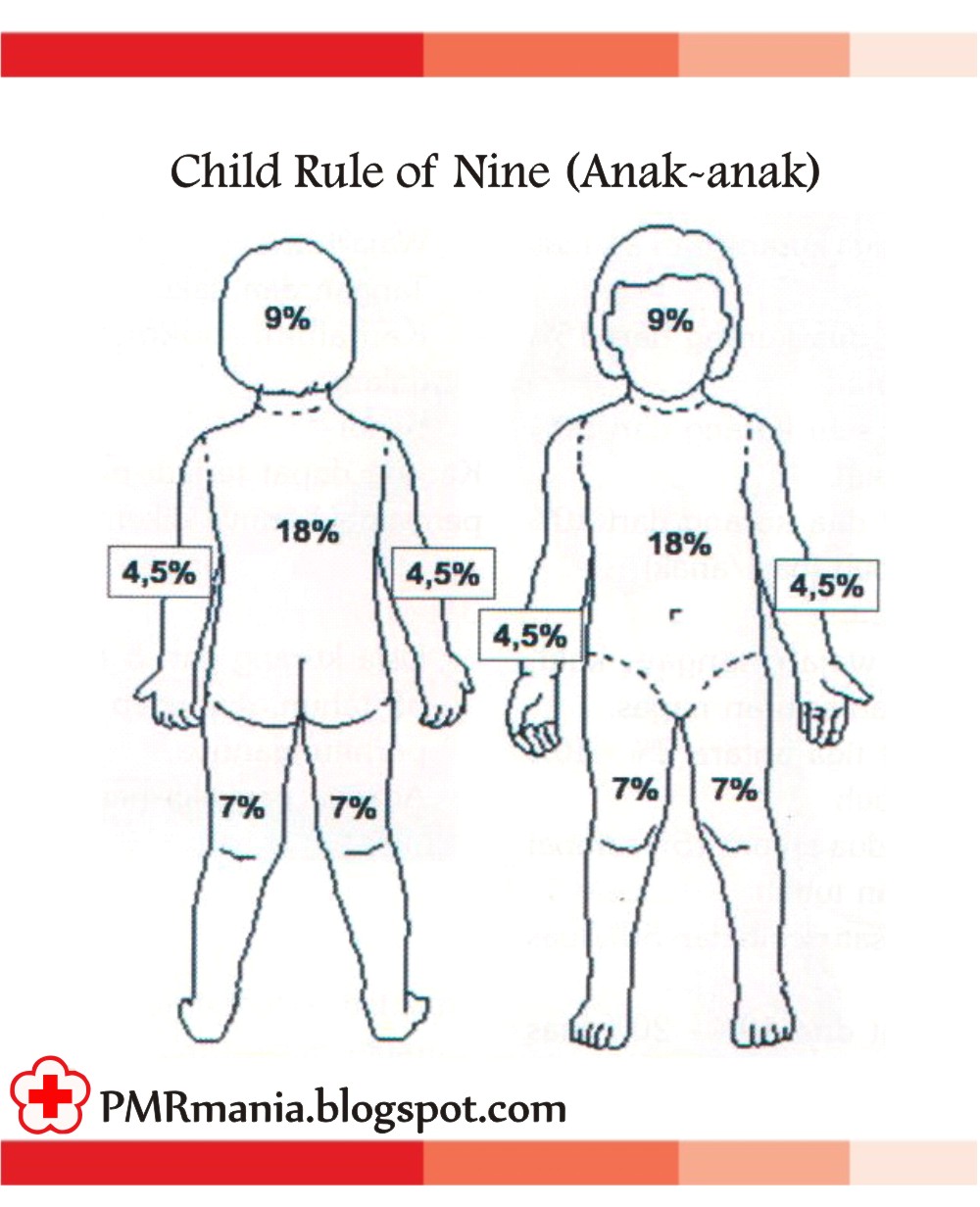
- Regular follow-up appointments
- Scar management therapies
- Reconstructive surgeries if necessary
The initial assessment using the Rule of Nines sets the stage for this long-term care plan, highlighting the importance of accurate early evaluation.
Education and Prevention: Reducing Burn Incidents
While understanding burn assessment and treatment is crucial, prevention remains the best strategy for reducing burn-related injuries and deaths.
Public Awareness Campaigns
How can we reduce the incidence of burn injuries? Public education plays a vital role. Effective strategies include:
- School-based fire safety programs
- Community workshops on burn prevention
- Media campaigns highlighting common burn hazards
Workplace Safety Measures
Many burn injuries occur in occupational settings. Implementing and enforcing strict safety protocols can significantly reduce these incidents. Key measures include:
- Proper training for handling hazardous materials
- Regular equipment maintenance and safety checks
- Provision and use of appropriate personal protective equipment (PPE)
By combining effective assessment tools like the Rule of Nines with comprehensive treatment approaches and robust prevention strategies, we can significantly improve outcomes for burn victims and reduce the overall incidence of burn injuries in our communities.

What Is It, and How Is It Used?
Written by WebMD Editorial Contributors
Medically Reviewed by Dan Brennan, MD on November 27, 2021
- Parts of the Rule of Nines
- Why Is the Rule of Nines Helpful?
- Types of Burns
- The Rule of Nines in Burn Treatment
- Limits of the Rule of Nines
The rule of nines is a tool used to estimate a burn’s percentage of your total skin. It divides your body into sections by multiples of 9% each.
The sections in the rule of nines are:
- Head: 9%
- Genitalia: 1%
- Arm: 9%
- Leg: 18%
- Torso: 36%
The body sections can divide in half. For example, the front side of one arm or your head is 4.5% of your total body surface area. The front and back of your torso are 18% each.
These percentages are accurate for people over age 14.
The rule of nines gives an idea of how much of your total body’s surface area a burn takes up. This informs treatments based on the size and intensity of the burn injury.
This informs treatments based on the size and intensity of the burn injury.
Emergency medical responders are some of the medical workers who use the rule of nines most. They quickly estimate the burn area to decide on treatments on the way to the hospital.
The rule of nines applies to burns from all causes. The most common causes of burn injuries are:
Thermal.Thermal burns result from contact with a hot surface, object, or flames. The heat kills your skin cells. Common causes of thermal burns include:
- Steam
- Boiling liquids
- Hot metals
- Fires
Electrical. Electrical burns come from direct contact with an electrical current. Electrical currents are high amounts of energy that flow through wires. Accidents that cause electrical burns include:
- Touching exposed wires
- Using faulty machinery or electrical equipment
- Touching a power line or pole
- Touching an electrical device that water is touching, such as a hair dryer in the sink while it’s still plugged in
- Lightning
Electrical burns can damage other areas besides your skin. Electric shock can weaken your muscles, impact your vision, or in severe cases stop your heart.
Electric shock can weaken your muscles, impact your vision, or in severe cases stop your heart.
Chemical. Chemical burns come from contact with harsh or dangerous chemicals. These chemicals can cause damage similar to thermal burns. Chemicals that can burn your skin include:
- Drain cleaners
- Wet cement
- Bleach
- Battery acid
Your skin has multiple layers between its surface and underlying tissues like muscle and fat. Burns have degrees based on how deep they reach into your skin.
First-degree. First-degree burns affect only the top layer of skin (called the epidermis). They can cause redness, skin dryness, and pain. First-degree burns usually heal with no scarring.
The rule of nines usually isn’t needed in first-degree burn care.
Second-degree. Second-degree (or partial-thickness) burns reach the deeper layers of your skin (called the dermis).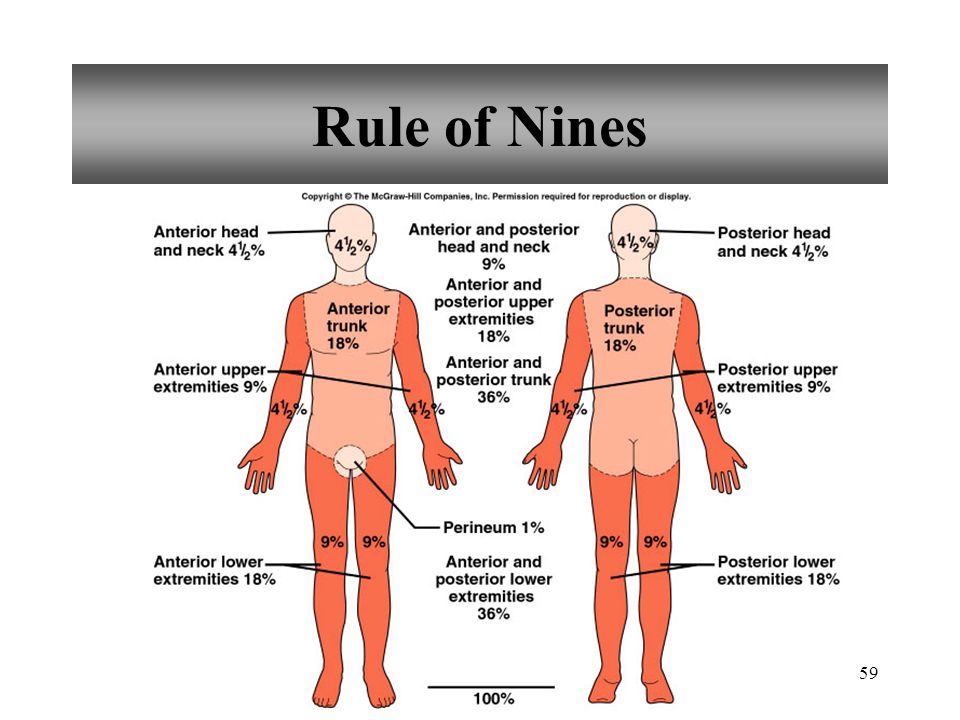 They often swell and blister. Second-degree burns can leave permanent scars.
They often swell and blister. Second-degree burns can leave permanent scars.
Third-degree. Third-degree (or full-thickness) burns reach to the deepest part of your skin and parts below the skin, like hair roots and sweat glands.
Fourth-degree burns reach underlying fat. Fifth-degree burns reach muscle. Sixth-degree burns reach bone.
Burn injuries can seriously damage your skin and other parts of your body. Your immune system’s response to a severe burn can lead to shock, heart failure, and organ damage.
Medical providers need to know a burn’s relative size using the rule of nines to decide on treatments.
Burn treatments include:
Skin grafts. Skin grafting is a treatment that takes healthy skin from one part of your body and places it on an injured area. This helps protect the injury from infection.
Determining a burn injury’s total body surface area using the rule of nines can help doctors plan a skin graft treatment.
Fluid replacement. Severe burns can cause your body to lose too much fluid, like blood, sweat, and water, inside your cells. This means you may need a fluid IV to keep enough water inside your body.
A burn’s amount of total body surface area informs how much water should go in your IV line.
Human error. Burns can spread over your body so they are unevenly distributed across the rule of nines’ sections. A burn injury’s size, shape, and depth can make it hard to guess its percentage of total body surface area.
Inaccurate guesses can cause doctors to use too much fluid or too little fluid in treatment. This can lead to kidney problems, liver damage, swelling, and other issues.
Different body sizes. The rule of nines doesn’t apply to children or patients who are obese. Babies and children under 14 have different rules for estimating a burn’s percentage of total body surface area.
Many other rules for estimating a burn’s size can apply to patients who are obese. Based on their body shapes, different body parts have different percentages of total body surface area.
Top Picks
What Is It, and How Is It Used?
Written by WebMD Editorial Contributors
Medically Reviewed by Dan Brennan, MD on November 27, 2021
- Parts of the Rule of Nines
- Why Is the Rule of Nines Helpful?
- Types of Burns
- The Rule of Nines in Burn Treatment
- Limits of the Rule of Nines
The rule of nines is a tool used to estimate a burn’s percentage of your total skin.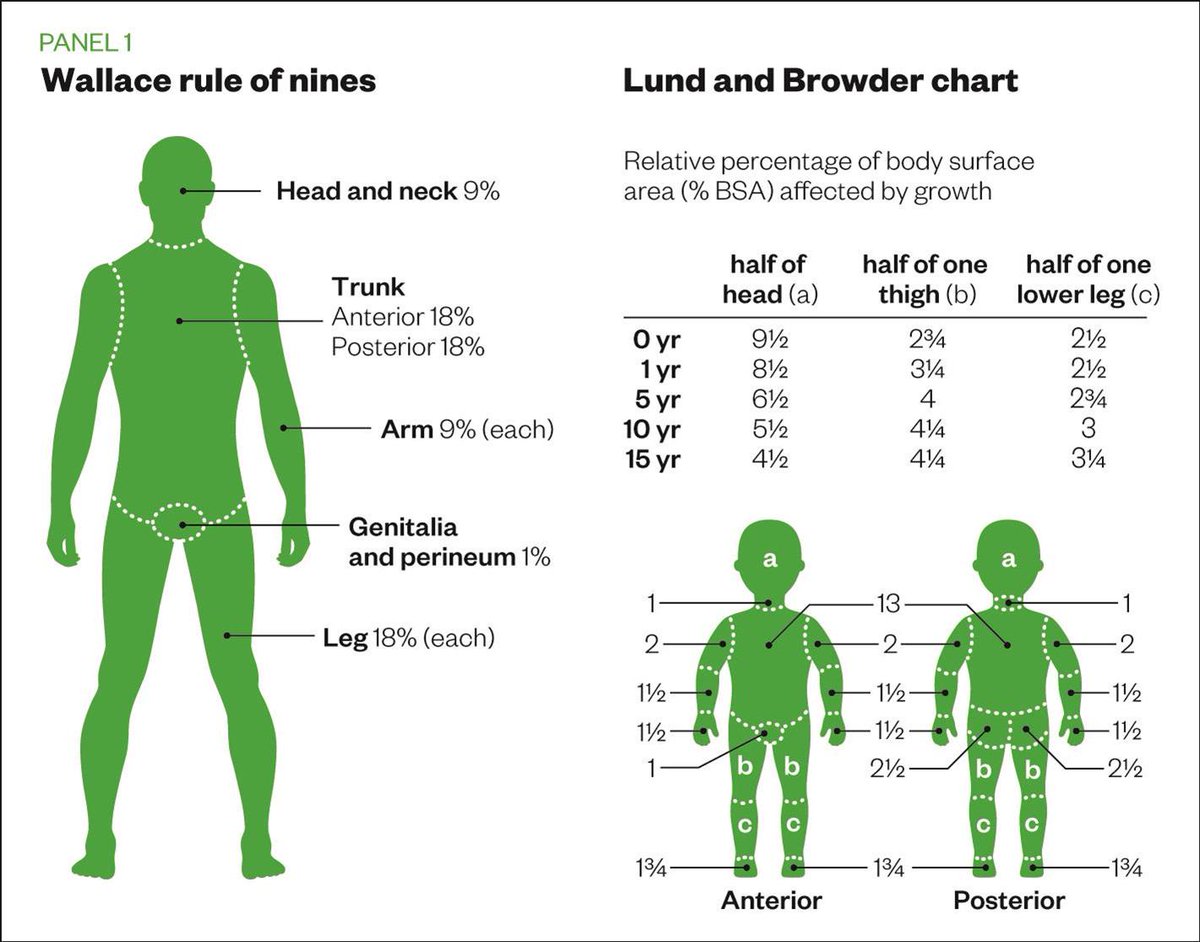 It divides your body into sections by multiples of 9% each.
It divides your body into sections by multiples of 9% each.
The sections in the rule of nines are:
- Head: 9%
- Genitalia: 1%
- Arm: 9%
- Leg: 18%
- Torso: 36%
The body sections can divide in half. For example, the front side of one arm or your head is 4.5% of your total body surface area. The front and back of your torso are 18% each.
These percentages are accurate for people over age 14.
The rule of nines gives an idea of how much of your total body’s surface area a burn takes up. This informs treatments based on the size and intensity of the burn injury.
Emergency medical responders are some of the medical workers who use the rule of nines most. They quickly estimate the burn area to decide on treatments on the way to the hospital.
The rule of nines applies to burns from all causes. The most common causes of burn injuries are:
Thermal.Thermal burns result from contact with a hot surface, object, or flames.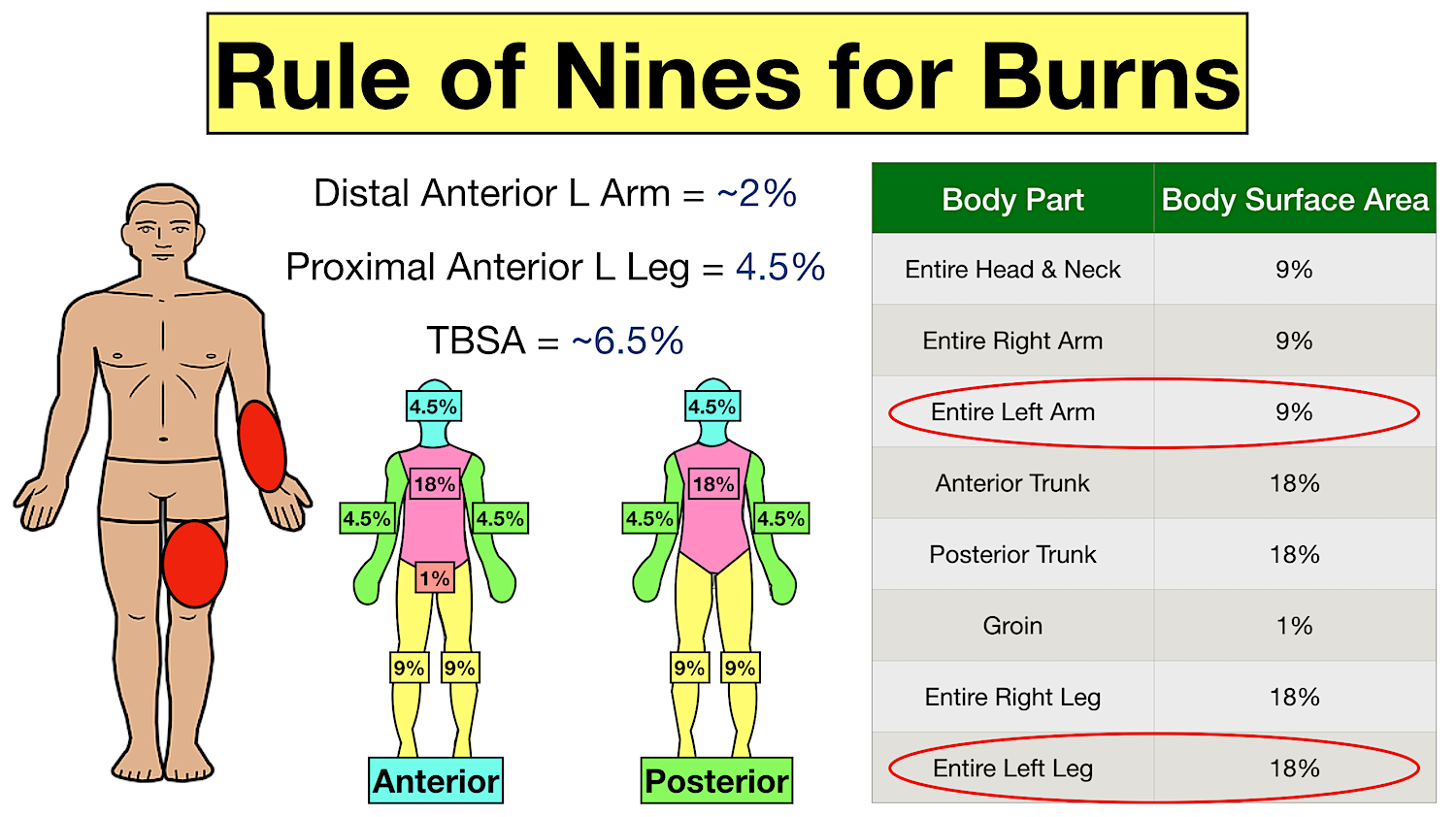 The heat kills your skin cells. Common causes of thermal burns include:
The heat kills your skin cells. Common causes of thermal burns include:
- Steam
- Boiling liquids
- Hot metals
- Fires
Electrical. Electrical burns come from direct contact with an electrical current. Electrical currents are high amounts of energy that flow through wires. Accidents that cause electrical burns include:
- Touching exposed wires
- Using faulty machinery or electrical equipment
- Touching a power line or pole
- Touching an electrical device that water is touching, such as a hair dryer in the sink while it’s still plugged in
- Lightning
Electrical burns can damage other areas besides your skin. Electric shock can weaken your muscles, impact your vision, or in severe cases stop your heart.
Chemical. Chemical burns come from contact with harsh or dangerous chemicals. These chemicals can cause damage similar to thermal burns. Chemicals that can burn your skin include:
- Drain cleaners
- Wet cement
- Bleach
- Battery acid
Your skin has multiple layers between its surface and underlying tissues like muscle and fat.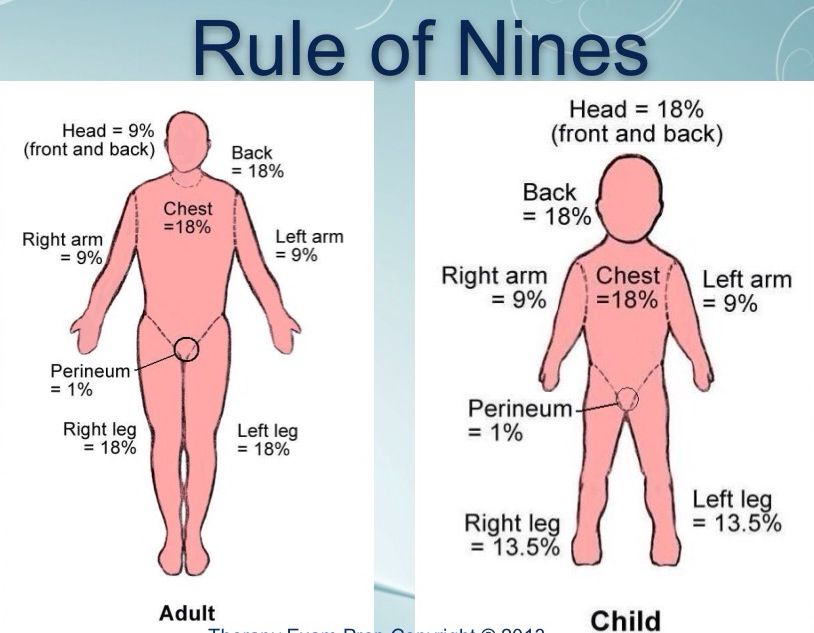 Burns have degrees based on how deep they reach into your skin.
Burns have degrees based on how deep they reach into your skin.
First-degree. First-degree burns affect only the top layer of skin (called the epidermis). They can cause redness, skin dryness, and pain. First-degree burns usually heal with no scarring.
The rule of nines usually isn’t needed in first-degree burn care.
Second-degree. Second-degree (or partial-thickness) burns reach the deeper layers of your skin (called the dermis). They often swell and blister. Second-degree burns can leave permanent scars.
Third-degree. Third-degree (or full-thickness) burns reach to the deepest part of your skin and parts below the skin, like hair roots and sweat glands.
Fourth-degree burns reach underlying fat. Fifth-degree burns reach muscle. Sixth-degree burns reach bone.
Burn injuries can seriously damage your skin and other parts of your body.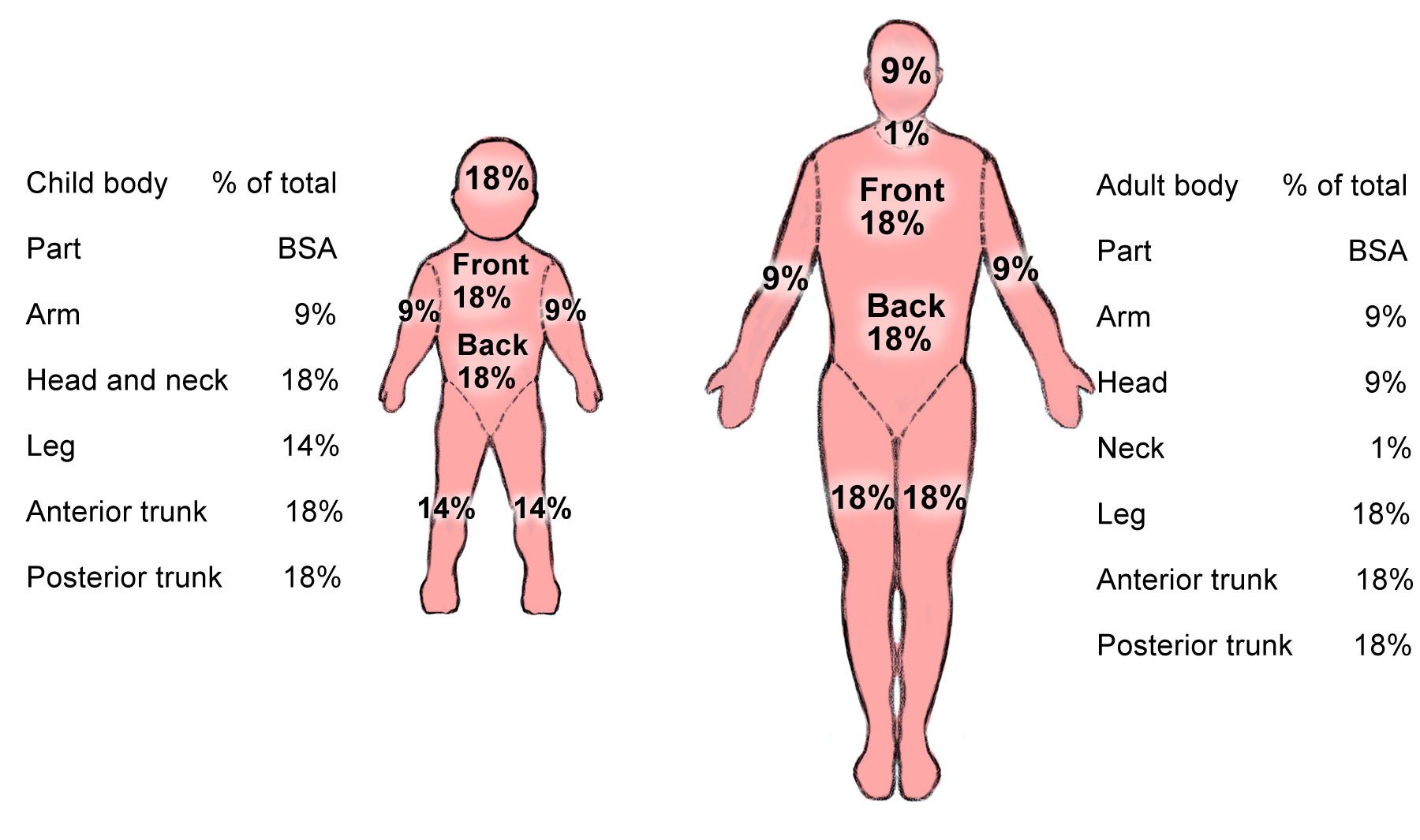 Your immune system’s response to a severe burn can lead to shock, heart failure, and organ damage.
Your immune system’s response to a severe burn can lead to shock, heart failure, and organ damage.
Medical providers need to know a burn’s relative size using the rule of nines to decide on treatments.
Burn treatments include:
Skin grafts. Skin grafting is a treatment that takes healthy skin from one part of your body and places it on an injured area. This helps protect the injury from infection.
Determining a burn injury’s total body surface area using the rule of nines can help doctors plan a skin graft treatment.
Fluid replacement. Severe burns can cause your body to lose too much fluid, like blood, sweat, and water, inside your cells. This means you may need a fluid IV to keep enough water inside your body.
A burn’s amount of total body surface area informs how much water should go in your IV line.
Human error. Burns can spread over your body so they are unevenly distributed across the rule of nines’ sections.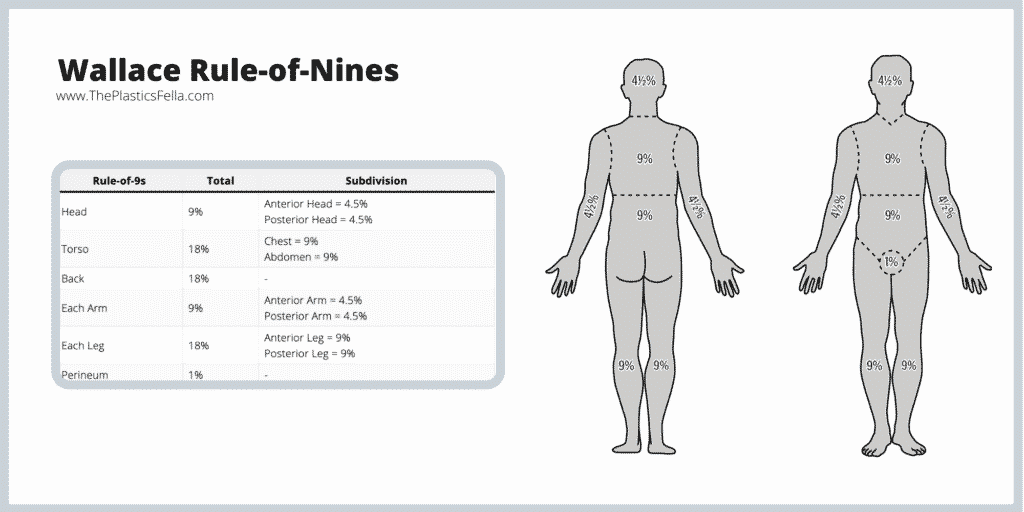 A burn injury’s size, shape, and depth can make it hard to guess its percentage of total body surface area.
A burn injury’s size, shape, and depth can make it hard to guess its percentage of total body surface area.
Inaccurate guesses can cause doctors to use too much fluid or too little fluid in treatment. This can lead to kidney problems, liver damage, swelling, and other issues.
Different body sizes. The rule of nines doesn’t apply to children or patients who are obese. Babies and children under 14 have different rules for estimating a burn’s percentage of total body surface area.
Many other rules for estimating a burn’s size can apply to patients who are obese. Based on their body shapes, different body parts have different percentages of total body surface area.
Top Picks
Rule of Nine
I like to work and I don’t like to relax.
In my senior years I worked sixteen to eighteen hours a day. Sleepless nights were common. Once a month I could work for a whole day and a little more – my head was still thinking, and then I could always sleep off. At such moments, I considered myself a hero of labor: everyone is sleeping, drinking and having fun, and I alone heroically climb the mountain.
Here’s what I learned about heroic work
The degree of heroism is in no way connected with the benefit that you bring, neither for yourself nor for those around you. The way you push yourself has little to do with the value you bring with your work.
People don’t give a damn how hard you work. The client does not need heroism, but a good result. How you get to this result depends much more on professionalism than on perseverance.
Sitting on tasks at night is a sign of an amateur. The amateur does not manage himself and his time well, negotiates badly, makes unnecessary promises, does not delegate tasks, gets distracted, procrastinates, spends too much time on insignificant things.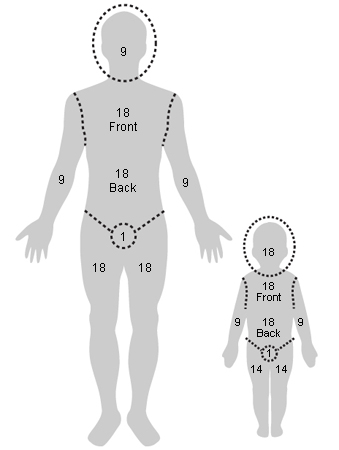 A professional not only does his job well, but also manages to do it on time.
A professional not only does his job well, but also manages to do it on time.
The professionals I look up to have severe limitations in their work. One of them starts the working day at 14:00. The other does not work on weekends. The third never does things on the same day they appear – he has the principle “Do it tomorrow”. I feel uncomfortable conforming to these restrictions, but I respect them. They are also respected by other people.
Heroism is a shortcoming
Unfortunately, I myself did not set any limits for myself. Therefore, he heroically worked on weekends, and on weekdays, and early in the morning, and late at night. And if you look back at all the work done, the most valuable and useful of what I did was done outside of this heroic work. Everything that was done urgently and overtime was usually not needed by anyone.
When I started thinking about it, I saw that there is nothing good in heroism. Sitting at night and bending to every request of a client is the path of a student, not a professional. Requests and comments will not decrease. There will be no less work. If nothing changes, I will forever remain a bearded, hunched-over editor at a computer at four in the morning.
Requests and comments will not decrease. There will be no less work. If nothing changes, I will forever remain a bearded, hunched-over editor at a computer at four in the morning.
To use the mountain metaphor, I am climbing a mountain without equipment. And the point is not to climb, but to move up. Both a helicopter and a lift are suitable for this. In order to become a professional and be more useful, I must build myself a helicopter.
So I start the experiment. From July 25, 2014, I introduce the “Rule of Nine”.
Rule of Nine
From Monday to Friday, work starts at nine in the morning and ends at nine in the evening. There is no work from nine in the evening until nine in the morning. There is no work on weekends.
Consequences of the rule of nine:
All work is planned from nine in the morning to nine in the evening. I take responsibility for the fact that I will fulfill all my promises for the day before nine in the evening.
No “tails” are closed after nine in the evening. If I understand that I am not on time for something, I go to the client and re-negotiate.
Any meeting, call or Skype ends at 9 pm, regardless of their phase and stage. This means that any meeting should begin no later than half past seven.
The Rule of Nine does not apply to courses, trainings and public speaking – mine or other people’s. I can break the rule of nine if I’m teaching or participating in someone else’s course, hosting Living Advice, or giving a public lecture.
The Rule of Nine can be a barrier to collaboration. For example, if your working day starts at 6 pm Moscow time, and the active phase falls at 3 am, then we will not dock. If this is an insurmountable obstacle for you, then we should not cooperate, even if we are perfect for each other.
P. S. For greater effect, I will consider buying a light and thin laptop that confidently holds a charge for 12 hours at full screen brightness.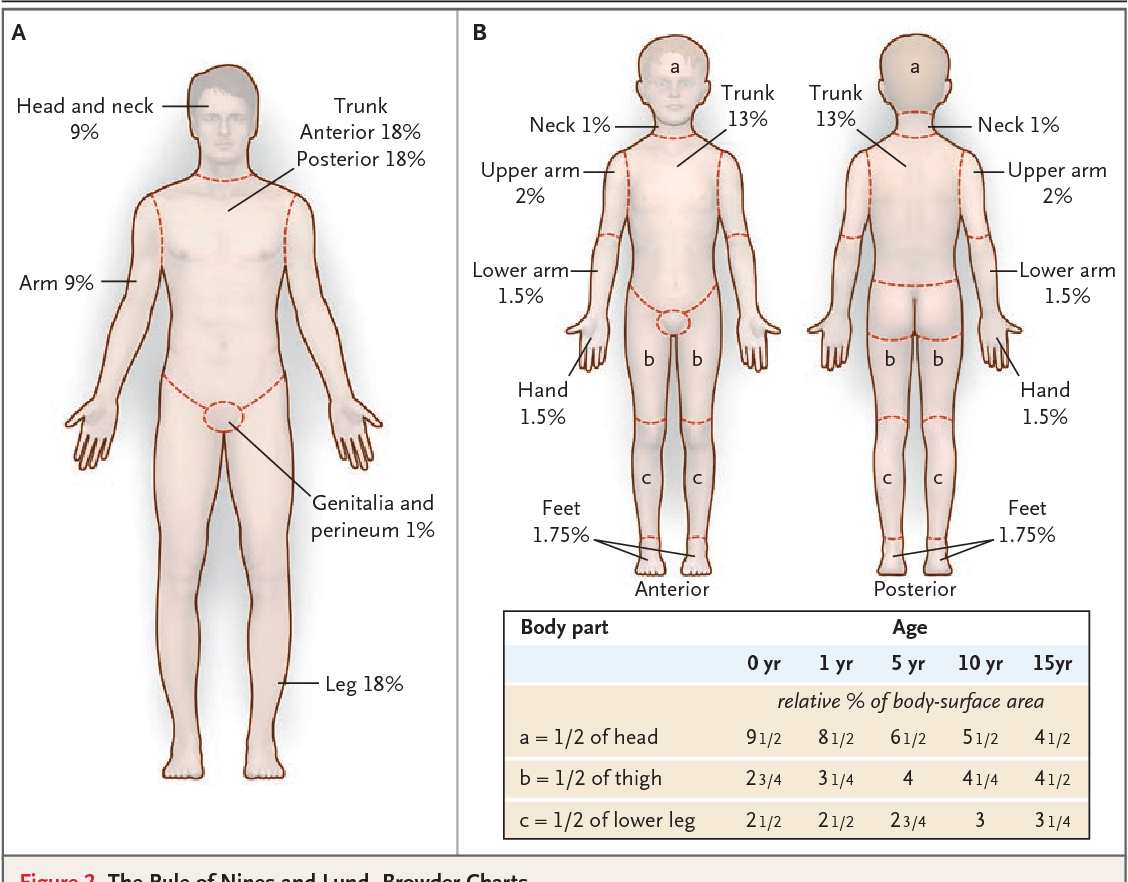 I heard that new macbooks can do this, but I don’t believe it. Connoisseurs, advise, please.
I heard that new macbooks can do this, but I don’t believe it. Connoisseurs, advise, please.
The 9-thing rule: a way to do everything
How often have you taken on several tasks at the same time, but in the end did not have time to do anything worthwhile for the whole day? At such moments, we usually dream of finding at least a couple of extra hours in the day and finding a way to be more productive and not burn out. Together with an expert, we analyze a simple but effective technique that will help you distribute the load and achieve all your goals for the day!
Tags:
Life style
time management
You must have wondered: “Why do people around me somehow magically manage to do everything, and I almost nothing?” If you are familiar with this problem, then our material will come in handy. Especially for VOICE readers, the psychologist spoke about the tricky technique “9 things to do”, which will help in proper planning of the day and will not let you drive yourself into stress. Try to follow these tips, and very soon you will notice that almost everything is subject to you!
Try to follow these tips, and very soon you will notice that almost everything is subject to you!
Elena Milto
Candidate of Psychological Sciences, promoter of the psychology of effectiveness and author of the method of sheff_thinking
There is a lot of information around, the flow of the desired is outlined, but, alas, there is not enough competence for everything. Hence the broken biorhythms, stress, burnout and other “charms” of the modern world. This can lead to apathy, fear and increased levels of anxiety. To avoid this, it is enough to apply a prophylactic from the arsenal of sheff_thinking.
The right “pill” here is, first of all, the ability to plan correctly. The vertical of effective planning is built in turn: hour, day, week.
The simplest and most effective way of prevention is the “9 things” technique. I use it myself and also often recommend it to our sorority members who are facing time constraints. So the formula is simple: 9=1+3+5.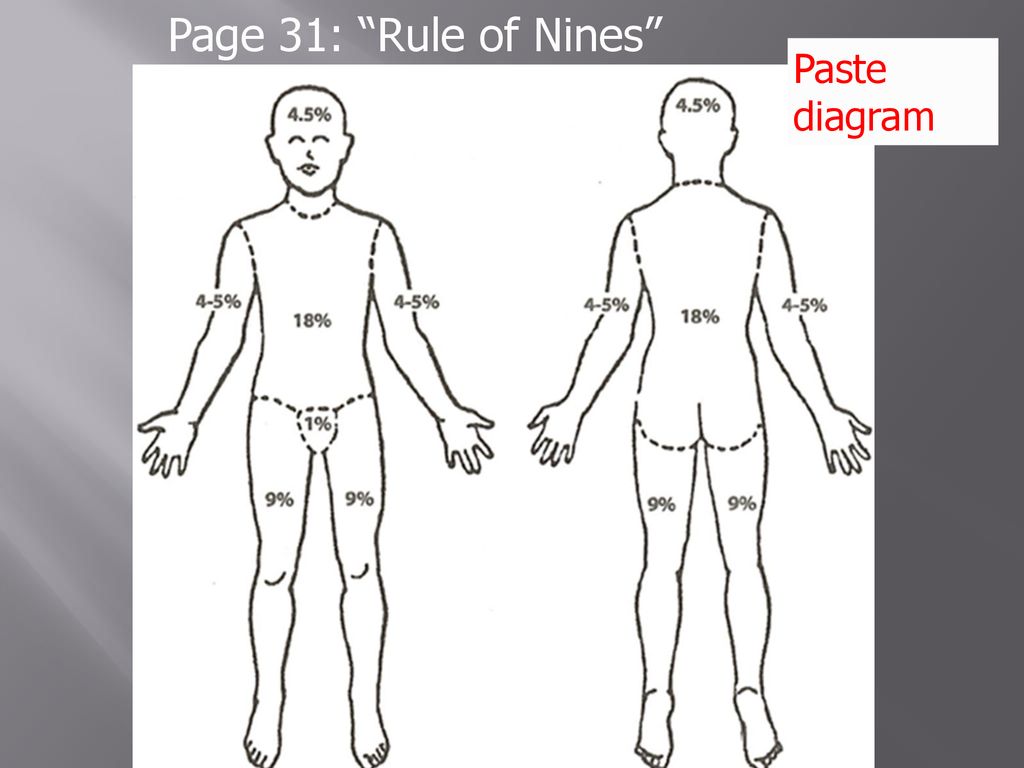 And now we understand in detail!
And now we understand in detail!
Nine tasks is the maximum that we promise ourselves to accomplish in a day: there are both large and small tasks among them. To begin with, we choose one of the largest and most urgent things – it will be the main and mandatory one. Next, we single out three tasks of “medium severity” and five more tasks that do not require a lot of effort, time and energy for implementation.
ADVERTISING – CONTINUED BELOW
Let’s analyze the formula using a simple example from my life:
- +1: I will write one chapter of my book, which is resource-intensive for me;
- +3: I will zoom with a colleague + set tasks for employees + make a birthday itinerary – these tasks are time-consuming, but not paramount;
- +5: I will sign the child up to the doctor + I will put the dishes in the dishwasher + I will publish a post on Instagram (The social network is recognized as extremist and banned on the territory of the Russian Federation) + I will order groceries at home + I will pay the bills.



